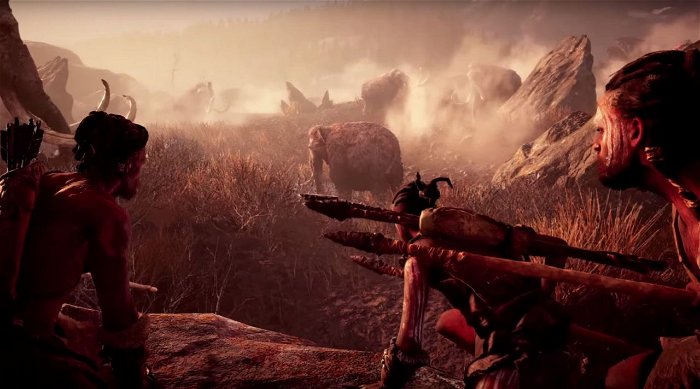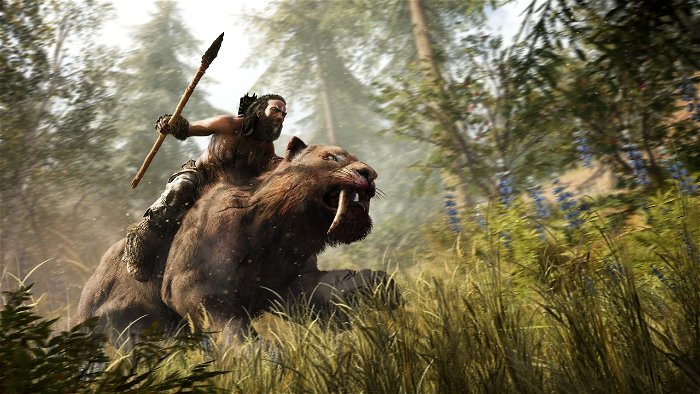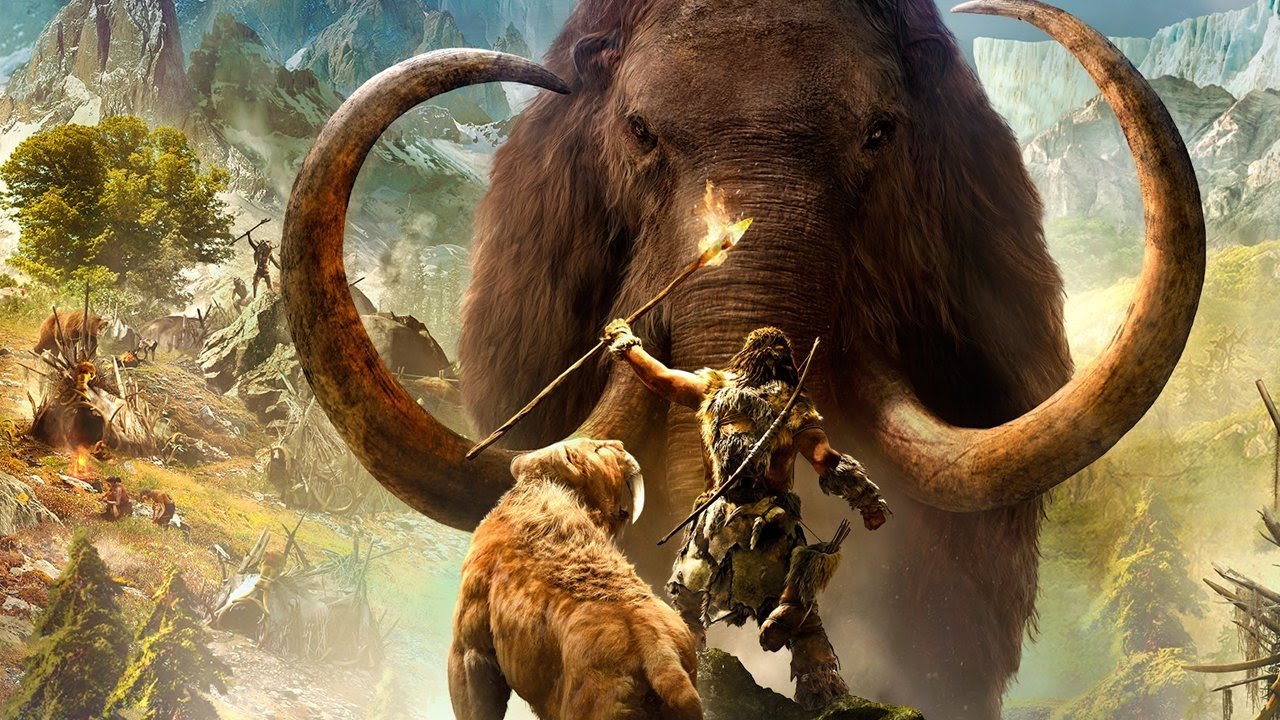The Far Cry series has always been a series that shows off some of the best tech in gaming. From the fire tech from
At Ubisoft Toronto, I had the pleasure to talk to David Robillard, the Technical Director for Far Cry Primal. Having worked at Ubisoft since 2006 and been involved with such titles as Child Of Light and Rainbow 6: Patriots, he is no stranger to game design. Now working with Far Cry Primal, he outlines the challenges that the team faced to build this prehistoric world, and the process they went about to overcome them.

CGMagazine: What engine is Far Cry Primal running on? Did you have a preexisting engine or did you start something fresh?
David Robillard: We had a lot of prototypes floating around in the Montreal studio that were kind of attached to the Stone Age or could’ve been used for the era. And once the opportunity arose to do a Far Cry game in the Stone Age, we said “hell yeah, let’s do it!” So we took all these prototypes and we brought them back into the Dunia Engine that was used to ship Far Cry 4.
CGM: So can you explain more about the Dunia Engine?
DR: Yeah, so the Dunia Engine was used to ship Far Cry 3, it was evolved on Far Cry 4 to bring the brand to the next generation consoles, and now we’ve used it again for Far Cry Primal.
CGM: So what were some of the technical challenges you had when working on Far Cry Primal? Did the engine give you all the tools you needed? Did you have to expand on it?
DR: Every game we make will always require certain specific tools based on where we’re bringing the player. One of the big things we did early on for Far Cry Primal was to optimize our rendering code and our engine code, just to bring much more density in our foliage and density in our biomes and our forests, but also to bring almost double the amount of NPCs that you can see within the same loading region. So if you play Far Cry Primal, you’ll see that there’s a lot more animals running around there’s a lot more predators and there’s a lot more NPCs running around the open world.
CGM: Now I’m noticing that, as you say, the open world has a lot of things going on. How do you keep track of all those assets at one time? Is it just each aspect of the world only rendering where you are? Or how does it keep track of everything?
DR: We have a global manager that manages our encounters in the open world, it’s properly named the encounter manager [chuckles], and that manager will look at where you are, which region, what type of assets should it spawn based on that, what type of encounters it’ll present to you, and it’ll try to make things interesting. It’ll try to make encounters that you haven’t seen in a while happen close to you—not in your face, but close by so you can hear them and kind of be like, “Hey, what’s going on? I wanna see what’s happening.”

CGM: I noticed in the game there were some random missions that you had to go on. Are those created the exact same way? Like, you haven’t done these missions in a while and it spawns them in?
DR: Yeah, exactly; those are also a part of the encounter manager. It’ll look at these little side missions and it’ll say, “Okay, well it’s been awhile since we’ve spawned a rescue quest, so let’s spawn a rescue quest nearby,” and you’ll get a little prompt and you’ll either choose to pick it or move on to something else.
CGM: Now how does this open world compare to previous Far Cry games? Is it bigger or smaller?
DR: It’s roughly the same size as Far Cry 4, but it’s a lot more dense than Far Cry 4, and that was one of the big challenges. In terms of density of assets, if you look at the temperate forests that we have at the beginning, you would not see that in Far Cry 4. There’s a lot more trees, there’s a lot more foliage, and there’s also a lot more fauna. So that’s something that we really tried to work on and achieve as we were optimizing early on in the project.
CGM: Now I’m noticing there’s a lot of new creatures in this world and you’ve brought a lot of mega fauna from this time period into the game. Were any of those things that you wanted to put into the game but were a challenge?
DR: Yeah, so the mammoths themselves were kind of a challenge. We weren’t sure if we were gonna be able to support them just because of the sheer size of them and the way that we would animate them, the way that we would make their fur look, and also the way that they would move around in the world. Like our Nav Mesh, which is basically a construct that allows the AIs to navigate the world, we were worried it wouldn’t support the mammoths.

CGM: Now, were there any technical challenges bringing in the beast mastery or is that just another aspect of the game?
DR: That is, of course, a big, big feature for us. So for a lot of it it was, “how do you get the reactiveness right but how do you also make the beast kind of feel a little more vicious and primal and make it look like it has its own instincts?” A lot of that came through iteration and playtesting over and over and discussing between our studios in Montreal and Toronto and we added certain takedowns that it would do based on certain contexts.
CGM: Now, we’re dealing with the present generation of consoles, is this a game that could only exist on PC, the PS4 and Xbox One?
DR: With the density of assets and the number of NPCs, yes, it would not have been possible to be on the previous generation.
CGM: Far Cry kind of had this modern day feel; you’re always a fish out of water. Why the choice to go with a seasoned warrior in this one, compared to the fish out of water with people kind of discovering the world, as it were.
DR: ‘Cause, in a sense, if you’re going to be put in the stone age and you’re just going to be this tourist, I think the game would’ve been done in five minutes. Something would’ve killed you; you’d be dead. So we wanted to supply the player with a character that already has a basic knowledge. He’s able to hunt, he’s got some skills, and to just be able to progress from there. He’s still very vulnerable; he’s nowhere near the top of the food chain when you start the game. His goal is to get there and get his tribe back together.

CGM: So now when you’re going from previous Far Cry games to this one, why the divergence from going from a modern day setting to the stone age. You mentioned previous examples you were working on, but where’d that come from?
DR: Yeah, so we had some ideas floating around the Montreal studio that would either be proper in the Stone Age era, like a very survival prototype and when the opportunity arose to do something our creative direction pitched it and it was basically, “Yeah, the stone age fits what Far Cry is.” Far Cry is about going to someplace you don’t know, being in an alien world and trying to survive. It’s about being on the frontier and the Stone Age is pretty much the first frontier that man faced.
CGM: Now, graphics engine wise, will the game differ from—I’ve only seen on PS4—will it differ from PC, Xbox, and PS4, or will it all kind of look the same?
DR: It will all look very similar; we try to bring the same level of quality to all our consoles. On PS4 and Xbox, we are limiting the resolution to 1080 and we’re limiting the framerate to 30 FPS. On PC, all of that is based on the hardware you have.
CGM: Now, when you’re dealing with this kind of lush, vibrant world and as the game progresses, is there anything to consider from a technical aspect as you explore more of the world and more things unlock and there’s more things for the system to remember? Does that pose a challenge to you as the developer?
DR: Yeah, of course. The tricky part is that when you start the project, your metrics and your guidelines for content creation are generous enough that you can explore the creativity and make something very interesting and appealing to the player but also strict enough and precise enough that you’re not going to be shooting yourself in the foot at the end. So that was a tricky part. And the way we adjusted, we gave guidelines that would scale up every time we hit a new milestone. We give them a little more juice and a little more juice and when they came back and said, “Hey, we would really like to push this prototype. It’s awesome; there’s a lot more diversity but it doesn’t fit into your memory or your performance budget,” then we group up and try to profile what’s causing the bottlenecks and see if we’re able to fix it.

CGM: Now, I just noticed that there are a lot of different characters and creatures in the game that you can interact with. Was the scope bigger when you started the project? Did you say you wanted these 30 things in the game but you kinda had to cut it down?
DR: There was a bigger scope at the start. Initially we would’ve liked to be able to tame all of the animals. However, for the design implications and for quality implications, we decided only to restrict ourselves to predators.
CGM: Was that something that the team decided that, that has to be in the game to make it the perfect experience?
DR: Well, we always wanted the mammoths to be an icon of our project and it’s cool to have them in there and it’s cool to see them around in their little herds. Stay clear or they’re gonna get angry! But at some point, Takar is gonna unlock the skill to be able to ride the smaller mammoths, not the bigger ones. You’ll also be able to ride other animals such as sabre-toothed tigers and the bear.
CGM: Now, final question: for people that are coming to Primal that have never heard anything about it, what should they take away from first experiences? What are things that they should look for?
DR: The first thing they should look for is to make sure that you take your time, make sure that you gather resources, make sure that you do the first missions just to get that little bit of progression, that little tick that will allow you to go further out in the expanse. If you try to go, like you did in Far Cry 3 or 4, full on assault, you’re gonna get eaten; you’re gonna get killed pretty fast. Your first few hours in the game, you’re not the predator; you’re the prey. You look really tasty to everything that’s out there. Once you start getting your beast master skills up and you start having a wolf or a bear, then you’ve got a little more leeway. Then you can go out further, maybe see the other tribes, but you gotta watch out for them ‘cause they’re out to get you as well.




